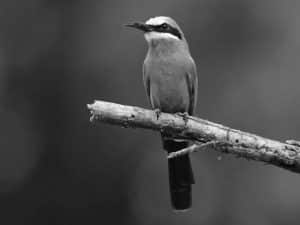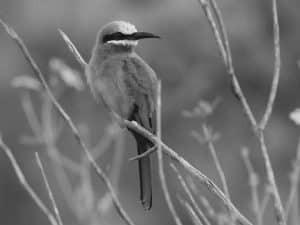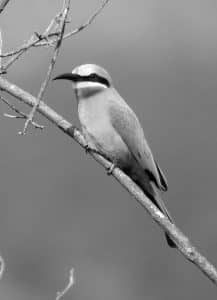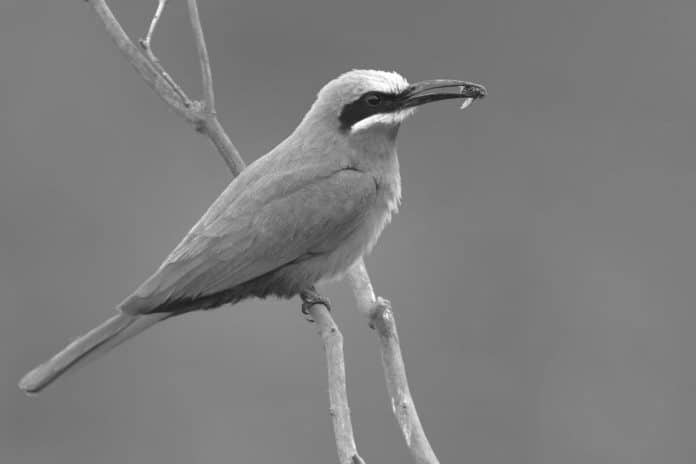Introduction to the White-Fronted Bee-Eater
Welcome to the stunning world of the White-Fronted Bee-Eater, a charming and distinctive bird species that graces the landscapes of Tanzania with its vibrant presence. With its striking appearance and fascinating behaviors, the White-Fronted Bee-Eater captivates birdwatchers and nature enthusiasts from around the globe. In this comprehensive guide, we will delve into the intricate details of this remarkable bird, exploring its habitat, behavior, nesting habits, conservation status, and much more. Get ready to embark on a captivating journey through the enchanting realm of the White-Fronted Bee-Eater in Tanzania.
Habitat and Distribution of the White-Fronted Bee-Eater in Tanzania

The White-Fronted Bee-Eater is prominently found in various regions of Tanzania, showcasing its vibrant plumage and engaging behaviors along the picturesque rivers and savannas. These magnificent birds prefer habitats with open woodland, grassland, and riverbanks, where they can thrive in the midst of abundant insect populations, their primary food source. The Rufiji River in the Selous Game Reserve and the Grumeti River in the Serengeti National Park are particularly renowned for hosting thriving populations of White-Fronted Bee-Eaters, offering nature enthusiasts unparalleled opportunities to observe these captivating creatures in their natural environment.
The distribution of the White-Fronted Bee-Eater extends across the eastern and southern regions of Tanzania, with their presence embellishing the landscapes of Mikumi National Park, Ruaha National Park, and other pristine wilderness areas. These birds are known for their communal roosting behavior, often congregating in large numbers on exposed branches or sandbanks, creating a mesmerizing sight for onlookers. The unique combination of diverse habitats and abundant insect life in Tanzania provides the White-Fronted Bee-Eaters with an ideal environment to thrive and perpetuate their species, contributing to the rich biodiversity of the region.
Characteristics and Behavior of the White-Fronted Bee-Eater
The White-Fronted Bee-Eater is renowned for its striking appearance, adorned with a white forehead, chestnut crown, and vibrant green plumage that adds a splash of color to the Tanzanian landscapes. These birds exhibit graceful aerial acrobatics as they skillfully capture flying insects in mid-air, displaying remarkable agility and precision. Their slender, elongated bodies and distinctive elongated central tail feathers further accentuate their graceful demeanor, making them a sight to behold as they navigate the skies with effortless elegance.
In addition to their remarkable physical traits, White-Fronted Bee-Eaters are known for their social behavior, often forming colonies that engage in cooperative breeding and communal roosting. These avian communities exhibit intricate social dynamics, with individuals participating in cooperative nesting activities and collectively defending their territories from potential threats. The melodious calls and chirps of the White-Fronted Bee-Eaters reverberate through the Tanzanian wilderness, adding a symphonic quality to the natural ambiance and captivating the hearts of birdwatchers and wildlife enthusiasts.
Breeding and Nesting Habits of the White-Fronted Bee-Eater
The breeding behavior of the White-Fronted Bee-Eater is a captivating spectacle that unfolds in the midst of Tanzania’s scenic landscapes, offering a glimpse into the intricate dynamics of avian courtship and nesting rituals. These birds engage in cooperative breeding, with multiple individuals contributing to the construction of nesting burrows in riverbanks or sandy cliffs. The communal efforts of the colony members result in the creation of elaborate tunnels that serve as secure havens for rearing their young, safeguarded from potential predators and the elements.
During the breeding season, the air is filled with the vibrant displays of the White-Fronted Bee-Eaters as they engage in courtship rituals, aerial displays, and vocal exchanges, creating an atmosphere of fervent activity and natural splendor. The female bee-eaters lay their eggs in the subterranean chambers of the nesting burrows, and both parents diligently tend to the incubation and care of the offspring. Witnessing the bustling activity of a White-Fronted Bee-Eater colony during the breeding season is an unforgettable experience, offering a profound insight into the intricate dynamics of avian family life and the marvels of nature’s reproductive processes.
Conservation Status and Threats Faced by the White-Fronted Bee-Eater

As with many species of wildlife, the White-Fronted Bee-Eater faces various conservation challenges and threats to its continued existence in the wild. Despite being relatively common in certain regions of Tanzania, the habitat loss and degradation caused by human activities pose a significant threat to the long-term survival of these enchanting birds. Deforestation, riverbank erosion, and agricultural expansion can disrupt the natural balance of the White-Fronted Bee-Eater’s habitats, leading to adverse impacts on their nesting sites and foraging grounds.
Furthermore, the indiscriminate use of pesticides and insecticides in agricultural practices can diminish the abundance of insect populations, which are vital for the sustenance of the White-Fronted Bee-Eaters. These factors, coupled with the potential disturbance caused by human activities and infrastructure development, underscore the importance of implementing conservation measures to safeguard the habitats and populations of these remarkable birds. Conservation efforts focused on habitat preservation, sustainable land management, and raising awareness about the ecological significance of the White-Fronted Bee-Eater are crucial for ensuring their continued presence in Tanzania’s diverse ecosystems.
Best Places to Spot the White-Fronted Bee-Eater in Tanzania
Tanzania’s diverse and picturesque landscapes offer a multitude of opportunities for observing the captivating beauty of the White-Fronted Bee-Eater in its natural habitat. Whether you are a seasoned birdwatcher or an avid nature enthusiast, several renowned locations in Tanzania provide ideal settings for encountering these delightful avian species. The Selous Game Reserve, with its expansive river systems and lush woodlands, stands out as a premier destination for observing White-Fronted Bee-Eaters in their element, offering spectacular sightings of their aerial displays and communal roosting activities.
The Serengeti National Park, celebrated for its iconic wildlife and sweeping savannas, is another prominent hotspot for encountering White-Fronted Bee-Eaters amidst the scenic backdrop of the Grumeti River and its verdant surroundings. Additionally, the Mikumi National Park and Ruaha National Park present captivating opportunities to witness the vibrant plumage and captivating behaviors of these remarkable birds as they grace the landscapes with their presence. Embark on a memorable safari adventure in Tanzania, and immerse yourself in the enchanting realm of the White-Fronted Bee-Eater as you explore the diverse ecosystems that serve as their thriving habitats.
Tips for Birdwatching and Photography of the White-Fronted Bee-Eater
When venturing into the wilderness of Tanzania to observe the White-Fronted Bee-Eater, it is essential to equip yourself with the knowledge and skills necessary for maximizing your birdwatching and photography experiences. Patience and attentiveness are key virtues when seeking out these avian gems, as they often exhibit swift and agile movements while foraging for insects or engaging in aerial displays. Binoculars and telephoto lenses can greatly enhance your ability to observe and document the captivating details of the White-Fronted Bee-Eater’s plumage and behavior, allowing you to appreciate their beauty and grace from a respectful distance.
To optimize your chances of sighting these birds, consider seeking guidance from experienced local guides or wildlife experts who possess intimate knowledge of the habitats and behavioral patterns of the White-Fronted Bee-Eaters. Their insights can provide invaluable assistance in identifying prime locations and opportune times for encountering these avian wonders, ensuring that your birdwatching and photography endeavors yield unforgettable encounters and captivating imagery. By exercising sensitivity and respect for the natural environment, you can partake in responsible and ethical wildlife observation, contributing to the preservation of the White-Fronted Bee-Eater’s habitats and populations.
Interesting Facts about the White-Fronted Bee-Eater
Unraveling the fascinating world of the White-Fronted Bee-Eater unveils a treasure trove of intriguing facts and captivating details that highlight the remarkable nature of these avian marvels. Did you know that the distinctive coloration of the White-Fronted Bee-Eater’s plumage serves as a form of aposematic signaling, warning potential predators of their unpalatability and associating them with the stinging insects they consume? This remarkable adaptation showcases the intricate interplay of evolutionary dynamics and ecological relationships that shape the unique characteristics of these birds.
Furthermore, the White-Fronted Bee-Eater is renowned for its cooperative breeding behavior, with multiple individuals participating in the construction and maintenance of nesting burrows, as well as the care and provisioning of the offspring. This communal approach to reproduction fosters tight-knit social bonds within the colonies and showcases the remarkable cooperative dynamics that underpin the avian societies of these captivating birds. Additionally, the aerial prowess of the White-Fronted Bee-Eater, characterized by agile maneuvers and precise captures of flying insects, demonstrates the remarkable adaptations and specialized foraging techniques that contribute to their ecological success.
The Role of White-Fronted Bee-Eaters in Tanzanian Ecosystems

The White-Fronted Bee-Eaters play a vital role in the intricate tapestry of Tanzania’s ecosystems, contributing to the regulation of insect populations and the dynamics of trophic interactions within their habitats. As consummate insect hunters, these birds exert a significant influence on the abundance and distribution of flying insects, including bees, wasps, and other airborne arthropods that constitute their primary prey. By preying on these insects, the White-Fronted Bee-Eaters help control their populations, contributing to the ecological balance and mitigating potential impacts on agricultural and natural systems.
Moreover, the nesting activities of the White-Fronted Bee-Eaters contribute to the modification of the landscape, as their burrowing behaviors can influence the structure of riverbanks and sandy cliffs, creating habitat niches for other species and influencing the dynamics of soil composition and erosion. The presence of these avian architects in the ecosystems of Tanzania underscores their significance as ecosystem engineers, shaping the physical and ecological characteristics of their surroundings through their nesting activities. By understanding and appreciating the multifaceted ecological contributions of the White-Fronted Bee-Eaters, we gain a deeper appreciation for their integral role in sustaining the biodiversity and ecological integrity of Tanzania’s natural landscapes.
Conclusion
In conclusion, the White-Fronted Bee-Eater stands as a captivating emblem of Tanzania’s rich avian diversity, enchanting observers with its vibrant plumage, graceful aerial displays, and intricate social behaviors. As custodians of the riverine landscapes and open woodlands, these remarkable birds contribute to the ecological tapestry of Tanzania, shaping the dynamics of insect populations and ecosystem processes through their foraging, nesting, and communal behaviors. By immersing ourselves in the enchanting realm of the White-Fronted Bee-Eater, we gain a profound appreciation for the intricate interplay of ecological relationships and evolutionary adaptations that underpin the natural world.
Embark on a journey of discovery and wonder as you explore the landscapes of Tanzania, seeking out the mesmerizing presence of the White-Fronted Bee-Eater amidst the scenic rivers and savannas. Whether you are drawn to their captivating aerial displays, communal nesting activities, or vibrant plumage, the White-Fronted Bee-Eater offers a wealth of enchanting experiences and profound insights into the marvels of nature. Embrace the opportunity to witness these white-crowned beauties along Tanzanian rivers, and immerse yourself in the captivating allure of the White-Fronted Bee-Eater, a living testament to the splendor of Tanzania’s natural heritage.

































